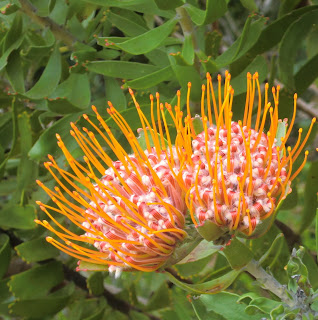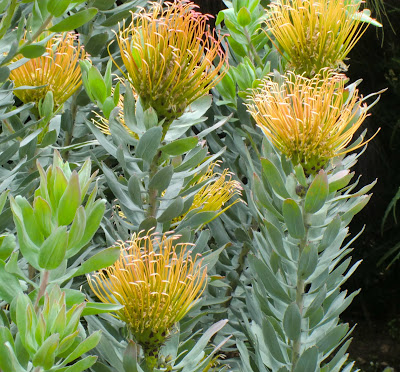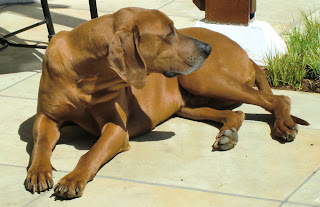We visited Cape Town during our 2003 SAS voyage and it left me feeling ambivalent because Cape Town proper is a vibrant, modern city with first-class restaurants and amenities while the surrounding townships are huge and jam-packed with an absolutely destitute population living in corrugated metal shacks. I find it difficult to revel in the niceties of the city knowing this. I think I was better able to enjoy the good parts of what we saw this time.
The last time we were here, we went on an SAS trip that stopped briefly at Kirstenbosch Botanical Garden and I knew that if I ever came back, I’d like to go again.
We were lucky because we arrived in Cape Town during the peak time to see proteus blooms. Cape Town is part of a unique ecosystem which features fynbos (fain boss) plants. They are very unusual plants and the proteus is chief among them.
We spent at least 4 hours walking the gardens admiring flowers, birds and some insects. The South African version of the hummingbird is the sun bird - it look as if they’d been spray painted with colorful metallic paints. There were also Egyptian geese, Guinea fowl, starlings, doves and some very large native pigeons.
At one point, we saw two of these pigeons in a tree and as we approached one took flight while the other one thrashed about. Puzzled, we stepped closer to find that it had somehow gotten its head in a “v” of a branch and was hanging by its neck. It was one of the oddest situations I’ve seen an animal get itself into. Luckily, Greg was tall enough to grasp the branch and give it a shake which allowed the bird to free itself and fly away!
DAY TWO - A HIKE
Our friend Kathy Poole contacted a University of Oregon alum, Oliver, who founded Volunteer Adventure Corps in Cape Town. Oliver arranged for us to go on a hike (called Boomslang Cave) in the Table Mountain National Park with several U of O students who are on the voyage. He used the van that they use to ferry interns about and a great driver, Sly, accompanied us. We didn’t see any baboons on the hike although the road signs had us on the lookout.
The hike was a bit strenuous, especially considering the fact that it is difficult to get much exercise on the ship. It was worth it though. After a fairly steep climb through fynbos and a crawl through a cave (we got to see a lot of bats there) we emerged high above Kalk Bay for some great views.
We also saw some interesting insects along the way.
After the hike we went to The Brass Bell restaurant and I enjoyed a regional specialty – thin crust pizza with bacon, avocado, mild feta and some sweet, spicy papadew peppers. It calls for cranberry sauce instead of the papadews but cranberry sauce just didn't sound right. It was very tasty with the papadews!
Day Three - Wine Country
On the third day of our stay in Cape Town, Oliver arranged for Sly to drive a group of us about the Constantia region to do some wine tasting at three vineyards. It was a beautiful day and we all had a great time. The first vineyard, Buitenverwachting, had some nice wines but nothing that wowed me. I'm not sure what "disposing" of wine is...unless it is just what it sounds like.
It was a beautiful setting and part of Blood Diamond was filmed there. We even got to meet one of the extras.
He was very handsome and there was a ridgeback puppy there too!
Our second stop, High Constantia, was everyone’s favorite because its owner, David, was very engaging and he clearly loves what he does.
He had been in banking and turned his hobby of wine making into his full-time job. I enjoyed his sparkling white wine and we splurged on a bottle – High Constantia Clos Andre 2007. It is 70% chardonnay and 30% pinot noir and at 1.5 g residual sugar per liter, very dry. David was showing Greg and another guy how to cork a bottle of sparkling wine and first allowed them to try it on an empty bottle. Then, he showed them how he removes the sediments from a finished bottle and allowed them to cork that one. Since their corking job was less than perfect, he gave us the bottle to take back to the ship to share with the group later in the voyage!
David also arranged for a chef to make us a fabulous lunch of chicken skewers, carmelized spiced corn cakes (a favorite with everyone), asparagus, a fabulous salad of fresh greens – something we are all missing on the ship, a couple of traditional Cape dishes and raw oysters (I normally DO NOT like oysters, but these were GOOD).
We lingered so long at this second winery that we spent just a short time at Groot Constantia – the oldest winery in the area. I’ve had some of their wines before and bought a bottle of Syrah without tasting it.
Unfortunately, I don’t think I’m going to be able to keep our special Spanish cheese, Payoyo, in a good state until we get home. I can’t get the humidity right in our little refrigerator. So…sorry cheese-loving friends I think it will be shared at the party where the bubbly is uncorked!
We made our way back to Cape Town and woke up with an excellent latte at Origin coffee house. We liked it so much a bag of coffee made its way back to the ship with us!
Later that night, we went to Savoy Cabbage for dinner. The food was excellent and I managed to choke down some more wine. I had some awesome lamb and Greg had warthog. Both were very well-prepared.
Greg's warthog...
My lamb...
A friend and I shared a dessert that can only be described as looking like scoops of ice cream, but tasting like chilled chocolate ganache! It was heaven.
Day Four - Cooking in Bo Kaap
The Cape Malay cooking class began with a tour of the Bo Kaap neighborhood of Cape Town. It is a Muslim area distinguished by its colorful buildings. Interestingly, it is known as the Cape Malay neighborhood when most are not of Malaysian descent.
We stopped at a spice shop where we learned about various spices used in “Cape Malay” foods and were able to purchase some things.
I had intended to put some spice pictures in here, but they seem to have disappeared from my laptop...
I took a chance and bought some dried fruit in an unlabeled bag which turns out to be the best dried mango I’ve ever eaten (sorry Sally it is going fast). I also purchased some of their “barbecue” spices which ended up being one spice used in some of the food we prepared.
Did you know that they have some interesting varieties of incense?
The cooking class was held in a home and taught by a local woman who was very charming and spunky. Last year, she played touch rugby on a team with her 14 year old daughter!
We made cheese and onion samoosas which are much like the Indian ones except that the skins are much more like won ton skins than the pastry-like ones of the Indian version. I am hoping to attach the recipes for these things because everything we made was excellent.
The rest of the cooking centered on the chicken curry. We made a sambal and roti to accompany the curry. The crucial part was the sambal made of onion, tomato, vinegar, sugar, cilantro and apricot jam (our teacher’s secret ingredient). The meal wouldn’t have been the same without it!

Day Five - Our on the Cape Peninsula
On our first day in Cape Town, we met a taxi driver, Gavin, from Zimbabwe who said he’d drive us on a Cape Peninsula tour for less than what a tour bus would. We decided to take him up on it and got another couple to go along with us. I’m a little seasick and worn out, so it will be anecdotes and pictures from here on out.
Our trip featured some breath-taking scenery…
We wound our way down the peninsula to Cape Point in the Cape of Good Hope – the most South Westerly point in the African continent. It was extraordinarily windy and we had some gale force winds. The scenery was amazing and we got to see many Chacma baboons – you basically cannot avoid them and have to be careful to not appear to be holding food or they will steal it from you. Kathy Ringrose, one of our traveling companions, nearly lost a new tote bag because it was inside a paper bag an apparently a baboon thought it was food.
We saw many baboons…
I particularly enjoyed this scene because the mother was so relaxed that she literally collapsed with her baby in her arms.
On our way back towards Cape Town we stopped at Boulders Beach to see the African penguins (previously called jackass penguins for the braying sound they make). I could’ve spent a lot of time with the penguins even though they were simply flopped on the rocks. It was molting season and some looked pretty pathetic. They are ashore and without food for the duration so we can’t blame them for lying about. My favorite thing was when they hopped over cracks in the rock. It seemed that some thought went into preparing for the “leap” which took a lot of effort but amounted to very little air time.
Don’t want to get a penguin stuck in the fan belt – makes a terrible noise:
We ate lunch with and had some interesting conversations with Gavin. In South Africa there are several categories of people based on their racial heritage. Gavin falls into the “colored” category which encompasses all of mixed race, Indians, etc. but not in the “black” category where, frankly, most Americans would place him. He stunned us all by tossing about the “N” word – he was describing rap music and how terrible he thinks the language is. He couldn’t understand how you could refer to a person as a “dog” or a woman as a “bitch”. We had to agree with him although I think to some extent the use of the “N” word by African-Americans is a form of empowerment because they can use it without repercussion (often) whereas anyone else would be raked over the coals for doing so (rightly so). Even hearing the word “colored” is difficult to stomach because of its use during our period of segregation. In any case, we told him that some of those words were offensive to most Americans and that he should avoid using them with Americans. What was particularly interesting was to realize that South Africans see Obama as “colored” and to learn that the “colored” S. Africans were celebrating the election of a “colored” president while the “black” S. Africans were rather unexcited because he wasn’t “black”. It was then that we explained that in the US, when someone has some African heritage, he is considered to be “black” (Halle Berry, Tiger Woods, Barack Obama, Lena Horne…) – it was an interesting observation to make.
Day Six - Operation Hunger Trip
On the last day of our stay we went on a SAS service trip to various sites served by an organization called Operation Hunger. It focuses on providing food to children in townships and rural areas. It is difficult to summarize one of these visits, so I’ll use pictures and just a few words.
Students at a school in the township. The choir sang for us.
These are some children at a school with which SAS has had a long-term history with. Each year the children are weighed so that none fall through the cracks of the feeding program.
A program for women who have suffered abuse to learn how to weave rugs and to have a place to sell them is associated with the school. Some examples of their work...
I saw this dog and thought "agility dog"... she was very sweet.
We visited this school and left some supplies - rice, maize flour, salt...a group of girls who participate in an after school program to keep them off the streets danced for us. Outside a neighbor lady was roasting sheep heads which are a local delicacy - unfortunately, I didn't get a good picture of it.
The children below have food from a soup kitchen - it was a bean dish with spices and a bit of meat. It actually smelled very good.
These are some of the government or habitat for humanity type homes build in the townships. They have solar heaters for water. The water is in clear tubes which should also sanitize it if it is exposed long enough. These homes are what replace the corrogated metal shacks shown in the first pictures in this blog. The population living in the metal shacks is enormous making the job of providing good housing daunting. With unemployment over 25% and because the black population was forced onto small tracts of desolate land during apartheid, it will be a long time before most see real change in their lives.
Whenever you feel disappointed about your own home or wish you had a bigger house, look at this and you'll probably feel better about where you live...



































































No comments:
Post a Comment